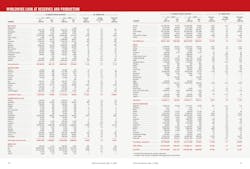Global oil and gas reserves increase in 2022
The world’s proven oil reserves total 1,757 billion bbl, up from 1,735 billion bbl a year earlier, according to Oil & Gas Journal’s annual assessment. Global proven natural gas reserves are now estimated at 7,456 tcf, up from 7,297 tcf surveyed last year.
The increase in global oil and gas reserves partly reflects higher commodity prices during the year and a corresponding upward revision to reserves in some countries. Additionally, OGJ listed Guyana’s oil and gas proved reserves in this report, the first time on record.
The published reserves figures rely on survey responses and official updates released by individual countries, which are not provided every year in many cases. OGJ changes its estimate for a country only when it receives evidence that a change is in order. Therefore, in a given reserves summary, a year-to-year change—or lack thereof—may not necessarily reflect a change that applies to the calendar year alone.
OGJ’s figures for oil reserves and production increasingly include natural gas liquids (NGL). Some countries’ gas reserves refer to dry gas reserves after moving NGL reserves explicitly into oil reserves.
When the original oil data are reported in metric tons, OGJ converted the data to volume unit b/d by applying conversion factors suggested by the International Energy Agency (IEA) for each country.
Meantime, OGJ forecasts global oil production in 2022 to average 92.36 million b/d vs. a 2021 average of 89 million b/d. Total OPEC production is set to increase by 1.7 million b/d in 2022, while non-OPEC supply will increase by 1.6 million b/d.
Reserves changes
Total proved oil reserves in the Asia-Pacific region increased slightly to 45.79 billion bbl in this year’s report from 45.7 billion bbl in the previous survey. Gas reserves increased to 581.27 tcf from 576.35 tcf a year ago.
According to the 2022 China Mineral Resources Report (CMR), China’s proved remaining oil reserves at yearend 2021 total 3.69 billion tons, an increase from 3.62 billion tons at yearend 2020. China’s remaining reserves for conventional natural gas were 6.34 trillion cubic meters (cu m), compared to 6.25 trillion cu m for the year-ago level. Coalbed methane reserves and shale gas reserves were 544 billion cu m and 366 billion cu m, respectively at yearend 2021. At yearend 2020, Coalbed methane reserves and shale gas reserves were 331.55 billion cu m and 402.62 billion cu m, respectively. According to CMR, compared with 2020, China’s capital investment in the oil and gas extraction industry increased by 4.2% in 2021.
Geoscience Australia updated its assessments for Australia oil and gas reserves (2019 data) in 2021, the first update since 2015. According to the agency’s estimates, Australia’s proven oil (crude oil, condensate, and NGL) reserves were 1.8 billion bbl in 2019, down from the 2015 figure of 2.45 billion bbl. Proven natural gas reserves were 96.5 tcf, down from 114 tcf estimated in 2015. However, proven reserves have not been updated since then.
According to the latest report from the Directorate General of Oil and Gas, Indonesia’s proven oil reserves as of Jan.1 2021 totals 2.25 billion bbl, down from 2.44 billion bbl a year ago. Its proven gas reserves are now 41.62 tcf, compared with 43.57 tcf a year ago.
According to the Ministry of Petroleum and Natural Gas, India’s crude oil reserves decreased to 587.33 million tons as of April 2021, compared with 603.36 million tons as of April 2020. Gas reserves increased slightly to 1,372.6 billion cu m from 1,371.9 billion cu m a year ago.
As of Jan. 1 2022, New Zealand has 36.6 million bbl of crude oil and condensate remaining, 829,000 tons of LPG remaining, and 1,056.8 bcf of natural gas remaining. As of January 2021, these figures were 35.2 million bbl, 886.5 tons, and 1,046 bcf.
Western Europe’s oil reserves fell 4.5%, while natural gas reserves were largely unchanged from the previous year’s report.
The latest annual resource report of the Norwegian Petroleum Directorate (NPD) shows that, at yearend 2021, Norway’s proven oil reserves, which include crude oil, condensate, and NGLs, amounted to 7.57 billion bbl, down from 7.74 billion bbl a year ago. Norway’s gas reserves at yearend 2021 increased slightly to 51.2 tcf from 50.9 tcf at yearend 2020.
The method NPD uses for classification of reserves is the United Nations Framework Classification System (UNFC). The North Sea is the area which has yielded the largest quantity, produced for longest, and possesses the largest remaining resources in fields and discoveries.
According to the latest estimates from the UK Oil & Gas Authority, UK’s proved oil reserves at yearend 2021 decreased to 1.8 billion bbl from 2 billion bbl at yearend 2020. Proven gas reserves increased to 0.9 billion bbl of oil equivalent (boe) from 0.8 billion boe.
According to Danish Energy Agency, Denmark’s estimated oil reserves decreased to 54 million cu m as of January 2022 from 65 million cu m as of January 2021. Gas reserves decreased to 989 bcf from 1,024 bcf.
Canadian conventional crude and condensate reserves are now estimated at 3.78 billion bbl, down from 3.8 billion bbl recorded a year ago, according to the latest evaluations by Canadian Energy Regulator (CER). The latest estimate of Canadian oil sands reserves decreased to 160 billion bbl from 161.2 billion bbl a year ago. In the natural gas section, CER only publishes natural gas “resources” and does not publish recoverable “reserves,” therefore OGJ made its preliminary estimate, which is subject to revisions.
According to Pemex’s annual hydrocarbon evaluations, as of Jan. 1, 2022, Mexico’s estimated proved reserves of oil totaled 5.96 billion bbl, down from 5.99 billion bbl as of Jan.1 2021. The current oil reserves consisted of 5.68 billion bbl of crude, 28.5 million bbl of condensate, and 362 million bbl of NGL. Mexico’s proved dry gas reserves total 7.13 tcf as of Jan. 1, 2022, up from 6.89 tcf as of Jan. 2021.
Brazil has declared proven oil reserves of 13.24 billion bbl by end-2021, up 11% from a year ago, according to the latest estimates from Brazil’s National Petroleum Agency (ANP). Proven natural gas reserves stood at 378.65 billion cu m at end-2021, up 12% from a year ago.
According to the Argentinian Institute of Oil & Gas (IAPG), Argentina’s proved oil reserves at yearend 2021 totaled 2.84 billion bbl, up from 2.4 billion bbl a year ago. Its proved gas reserves increased to 14.69 tcf from 14 tcf in the previous evaluation.
OGJ lists Guyana’s reserves for the first time. Guyana’s oil reserves increase to over 10 billion bbl, according to the Ministry of Natural Resources of Guyana. Also, according to Guyana’s Minister of Natural Resources, the country has 16 tcf of proven natural gas reserves.
OPEC reserves
The reserves figures reported for OPEC members are referenced from the organization’s latest annual statistical bulletin.
Total proved crude oil reserves for the current OPEC group remain largely flat from the year-ago level, standing at 1,241.8 billion bbl and total natural gas reserves move up slightly by 0.68% to 2,621.7 tcf.
Saudi Arabia’s crude oil reserves increased to 267.2 billion bbl from 261.6 billion bbl a year ago. Meanwhile, crude oil reserves reported by the United Arab Emirates (UAE) increased to 111 billion bbl from 107 billion bbl a year ago. Gas reserves of the country also increased 6% to 289.6 tcf.
The current OPEC’s oil reserves account for 71% of the worldwide total and gas reserves account for 35% of the world’s gas reserves.
US reserves
Proved reserves of US crude oil and lease condensate declined 19% to 38.2 billion bbl at the end of 2020 from 47.2 billion bbl at the end of 2019. Proved reserves of crude oil decreased by 8.4 billion bbl in 2020, and proved reserves of lease condensate decreased by 560 million bbl. This is according to the latest reserves report from the US Energy Information Administration (EIA).
Texas had the largest net decrease in proved crude oil and condensate reserves in 2020 (-3.1 billion bbl or 16%). North Dakota had the second-largest net decrease (-2.2 billion bbl or 38%). The largest net increase in proved reserves of crude oil and lease condensate in 2020 was in Utah (+91 million bbl or 30%).
US proved reserves of natural gas decreased 4%, to 473.3 tcf at yearend 2020 from 495.4 tcf at yearend 2019. This decrease was the second consecutive annual decrease in proved reserves of natural gas in the US. Proved reserves of dry natural gas decreased 4% to 445.3 tcf in 2020 from an estimated 465.4 tcf in 2019. However, producers in Alaska added a substantial new volume of proved natural gas reserves in 2020, quadrupling the state’s total to 36 tcf from 9 tcf.
The estimated volume of natural gas plant liquids (NGPLs) contained in proved reserves of total natural gas decreased 4% to 20.7 billion bbl in 2020 from 21.7 billion bbl in 2019.
EIA is scheduled Dec 2022 to update the yearend 2021 estimates of proved reserves. As OGJ went to press at the end of November, these figures are not yet available, so OGJ made its own estimates.
OGJ estimates that, by the end of 2021, US proven oil reserves, including crude oil, lease condensate, and NGL reserves, totaled 79 billion bbl, up 34% from the prior year. Dry natural gas reserves increased to 579 tcf, up 30% from a year ago. The upward revisions reflect higher commodity prices during 2021 as well as information observed from OGJ150 data. OGJ will update yearend 2021 US reserves with EIA data in next year’s report.
World oil production
Despite the OPEC+ group until recently increasing its production target, challenges in global oil supply persisted during the year, especially as Russia began to shut down more wells and producers continue to encounter capacity constraints. Meantime, since the fall in oil prices in 2014, the global upstream capital expenditure has been insufficient, resulting in bottlenecks in production capacity of traditional oil fields, making it difficult to achieve rapid production increases. Moreover, on Oct. 5, 2022, OPEC+ producers agreed to reduce crude oil production targets by 2 million b/d from their previously stated targets beginning in November 2022.
Global oil production in 2022 is expected to increase 3.7% and average 92.36 million b/d vs. an estimated 2021 average of 89 million b/d.
Total OPEC oil supply in 2022 is forecast to average 32.95 million b/d, compared with 31.25 million b/d last year, with Saudi Arabia poised to deliver the largest year-on-year growth in production. Production from the UAE is expected to increase 12% to average 3.8 million b/d. The UAE has produced significantly above its OPEC+ target since the start of 2022.
Non-OPEC supplies are expected to rise by 1.6 million b/d in 2022, with the US proving 77% of the increase at 1.2 million b/d. However, US light tight oil production growth has been limited by supply chain tightness and rising costs. In addition, Canada, Brazil, China, and Guyana also post solid but modest gains.
Canadian oil supply is expected to increase 2.4% in 2022 to 5.6 million b/d. Brazilian oil production is expected to increase 4% in 2022.
Oil production in Norway and the UK is expected to decline respectively by 3.3% and 4.5% this year due to heavy maintenance at major fields.
Russia’s oil production is expected to average 10.95 million b/d this year, slightly up from the year-ago level of 10.87 million b/d. As the EU embargo comes into full effect, Russia oil production is set to decline. Kazakhstan and Azerbaijan oil outputs are estimated to decline 4% and 1% in 2022, respectively.
Oil production in the Asia-Pacific region in 2022 is expected to be roughly in line with 2021 levels, as production growth in China offsets production declines elsewhere. China’s oil production will increase by nearly 4% to 4.15 million b/d in 2022, thanks to continued strong capital investment. Australia’s production will decrease around 4.5% this year, in part due to labor issues at Prelude FLNG. Production will fall in most other major Asia-Pacific producers, notably Indonesia and Thailand, reflecting a lack of investment and new projects.
About the Author
Conglin Xu
Managing Editor-Economics
Conglin Xu, Managing Editor-Economics, covers worldwide oil and gas market developments and macroeconomic factors, conducts analytical economic and financial research, generates estimates and forecasts, and compiles production and reserves statistics for Oil & Gas Journal. She joined OGJ in 2012 as Senior Economics Editor.
Xu holds a PhD in International Economics from the University of California at Santa Cruz. She was a Short-term Consultant at the World Bank and Summer Intern at the International Monetary Fund.
Laura Bell-Hammer
Statistics Editor
Laura Bell-Hammer is the Statistics Editor for Oil & Gas Journal, where she has led the publication’s global data coverage and analytical reporting for more than three decades. She previously served as OGJ’s Survey Editor and had contributed to Oil & Gas Financial Journal before publication ceased in 2017. Before joining OGJ, she developed her industry foundation at Vintage Petroleum in Tulsa. Laura is a graduate of Oklahoma State University with a Bachelor of Science in Business Administration.


